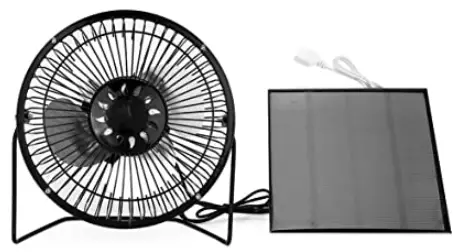In this short article, we’ll go over how to run a small fan directly from a solar panel without using a battery. Can you even power a small fan from a solar panel?
The short answer is yes, you can run a small fan directly from a solar panel, but it may require some tweaking or special equipment. Let’s talk more about it!
Can we directly connect a fan to a solar panel?
Yes, you can directly connect a fan to a solar panel, but you have to make sure it’s the right solar panel.
Solar panels produce direct current, or DC, power. In most cases, a solar inverter is needed to convert the DC power into usable alternating current, or AC, power—most appliances and electronics need AC power to run. Plugging in a solar panel directly to an electronic or device would most likely do nothing.
But let’s consider a case with a built-in mini power converter inside the solar panel. Some solar panels have built-in technology that allows the user to connect solar panels to their devices directly.
Examples

The AmazonCommercial 6-Inch USB Table Fan requires approximately 3 Watts of power to operate. For desk fans and other smaller fans that don’t need a lot of energy, the average solar panel will be enough to pull these fans.
Let’s take a 100-Watt solar panel, for example. The 100-Watt rating is the maximum output of the solar panel, so the solar panel will usually run at around 80% of the total power—80 Watts, in our case. On cloudy or rainy days where the sun is covered up, the solar panels usually produce 10-25% of their expected power output—10 to 25 Watts, in our case.
Using these real-life scenarios, your solar panel should theoretically be able to power a small fan, even on cloudy days. For power at night, you will need a battery
SMALLER SOLAR PANELS
For the math in our real-life examples, we used a 100-Watt solar panel, which was enough to power our small desk fan. If you are planning on buying a smaller solar panel, manufacturers make a wide variety of small solar panels, ranging from 10 Watts to 50 Watts.
However, be careful! The Wattage that it specifies on the box is the power output that you’ll get under direct sunlight. If you aren’t under direct sunlight, or if there’s atmospheric interference (clouds, rain, etc.), you will get a lot less power which may cause your fan to run slowly—defeating the purpose of a fan.
BIGGER FANS
Obviously, a 3-Watt USB desk fan isn’t enough to cool your body down entirely on a hot summer day. You can hook up a bigger fan, but be careful not to go over the “safe limit” of the solar panels—40-60% of the solar panel’s Wattage.
Our 100-Watt solar panel will usually be limited to around 40 Watts to 60 Watts (under direct sunlight cases). Here’s a table that provides the Wattage amounts for different types of fans:

Takeaways
- You can directly connect a fan to a solar panel
- The solar panel must have some sort of built-in power inverter.
- Fans will work the best when connected to a solar panel under direct sunlight (between 10 AM and 2 PM with no clouds).
- Solar panels usually produce 80% of the amount of Watts listed on the box.
- Solar panels usually produce 10-25% of the amount of Watts under cloudy skies.
If you decide that DIY solar powered fan isn’t for you, then check out our guides on the best solar camping fans and/or solar fans for car.

